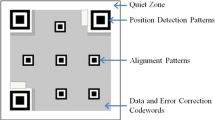Abstract
QR code is an important approach of information transmission and is widely used in our daily life. As a public patent, the message embeded in a QR code can be easily decoded by any QR code reader, thus can lead to information leaks when delivering the secret message with QR code. To overcome this weakness, we exploited the characteristics of Reed-Solomon code and turtle shell matrix to propose a simple yet efficient data embedding mechanism to hide secret messages in the QR code while maintaining the marked QR code valid. Different from the traditional schemes, the proposed scheme of this paper hides the secret messages without sacrificing the error correction capacity of QR code and is able to achieve a higher secret payload. Meanwhile, the public message of generated marked QR code still can be decoded by standard QR code reader. Such nature will reduce the risk due to the curiosity of the malicious users. Experiments were performed to evaluate the performance of the proposed scheme. Experimental results showed that the proposed scheme is robust to several common image attacks.











Similar content being viewed by others
References
Bui TV, Vu NK, Nguyen TT, Echizen I, Nguyen TD (2014) Robust message hiding for QR code. In: 2014 Tenth international conference on intelligent information hiding and multimedia signal processing (IIH-MSP). IEEE, pp 520–523
Chang CC, Liu Y, Nguyen TS (2014) A novel turtle shell based scheme for data hiding. In: Intelligent Information Hiding and Multimedia Signal Processing (IIH-MSP), 2014 Tenth International Conference on. IEEE, pp 89–93
Chiang Y-J, Lin P-Y, Wang R-Z, Chen Y-H (2013) Blind QR code Steganographic approach based upon error correction capability. KSII Transactions on Internet & Information Systems 7(10):2527–2543
Cox R (2012) Qart codes. http://research.swtch.com/qart. Accessed Dec. 2012
Elias P (1991) Error-correcting codes for list decoding. IEEE Trans Inf Theory 37(1):5–12
Erlangga W, Barmawi AM (2016) Increasing secret data hiding capacity in QR code using 3 times 3 subcells. In: International workshop on digital watermarking. Springer, pp 327–342
Fridrich J, Goljan M, Lisonek P, Soukal D (2005) Writing on wet paper. IEEE Trans Signal Process 53(10):3923–3935
Fridrich J, Goljan M, Soukal D (2006) Wet paper codes with improved embedding efficiency. IEEE Transactions on Information Forensics and Security 1(1):102–110
Huang P-C, Li Y-H, Chang C-C, Liu Y (2018) Efficient scheme for secret hiding in QR code by improving exploiting modification direction. KSII Transactions on Internet & Information Systems 12(5)
Inc. D-W (2003) QR code standardization. www.qrcode.com/en/about/standards.html. Accessed 24 Nov. 2017
Lin P-Y, Chen Y-H (2016) QR code steganography with secret payload enhancement. In: 2016 IEEE international conference on multimedia & expo workshops (ICMEW), Seattle, USA. IEEE, pp 1–5
Lin P-Y, Chen Y-H (2017) High payload secret hiding technology for QR codes. EURASIP Journal on Image and Video Processing 2017(1):14
Liu Y, Chang C-C, Nguyen T-S (2016) High capacity turtle shell-based data hiding. IET Image Process 10(2):130–137
Liu L, Chang C-C, Wang A (2017) Data hiding based on extended turtle shell matrix construction method. Multimed Tools Appl 76(10):12233–12250
Mielikainen J (2006) LSB matching revisited. IEEE signal processing letters 13(5):285–287
Teraura N, Sakurai K (2012) Information hiding in subcells of a two-dimensional code. In: 2012 IEEE 1st Global Conference on consumer electronics (GCCE), IEEE, pp 652–656
Tkachenko I, Puech W, Destruel C, Strauss O, Gaudin J-M, Guichard C (2016) Two-level QR code for private message sharing and document authentication. IEEE Transactions on Information Forensics and Security 11(3):571–583
Zhang X, Wang S (2006) Efficient steganographic embedding by exploiting modification direction. IEEE Commun Lett 10(11):781–783
Author information
Authors and Affiliations
Corresponding author
Additional information
Publisher’s note
Springer Nature remains neutral with regard to jurisdictional claims in published maps and institutional affiliations.
Rights and permissions
About this article
Cite this article
Huang, PC., Chang, CC., Li, YH. et al. High-payload secret hiding mechanism for QR codes. Multimed Tools Appl 78, 22331–22350 (2019). https://doi.org/10.1007/s11042-019-7600-x
Received:
Revised:
Accepted:
Published:
Issue Date:
DOI: https://doi.org/10.1007/s11042-019-7600-x




